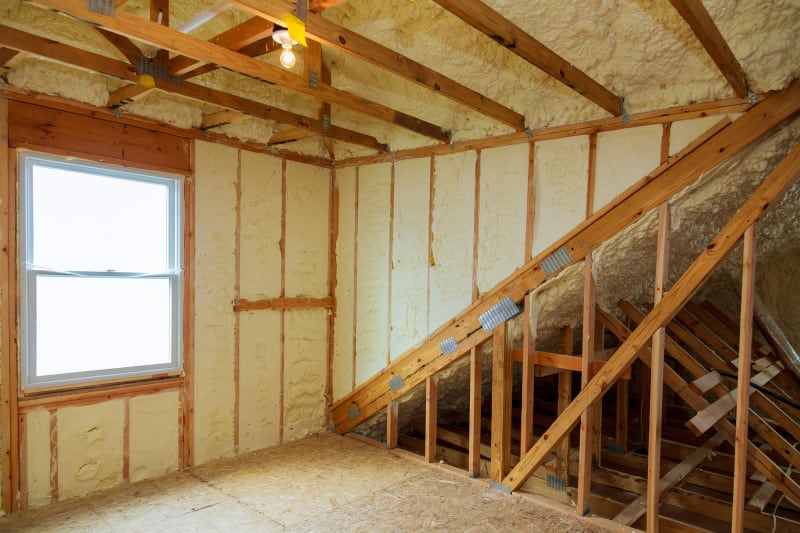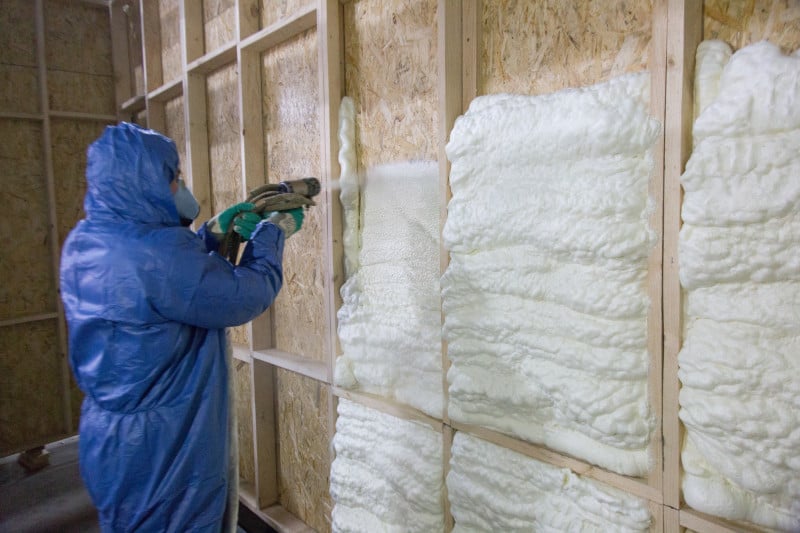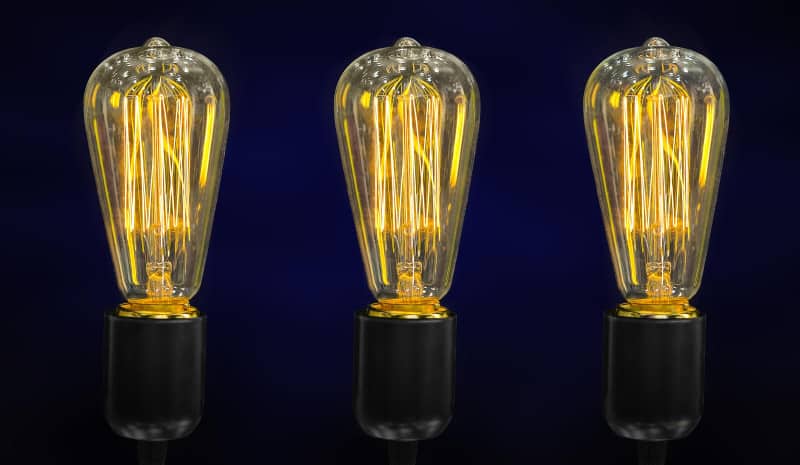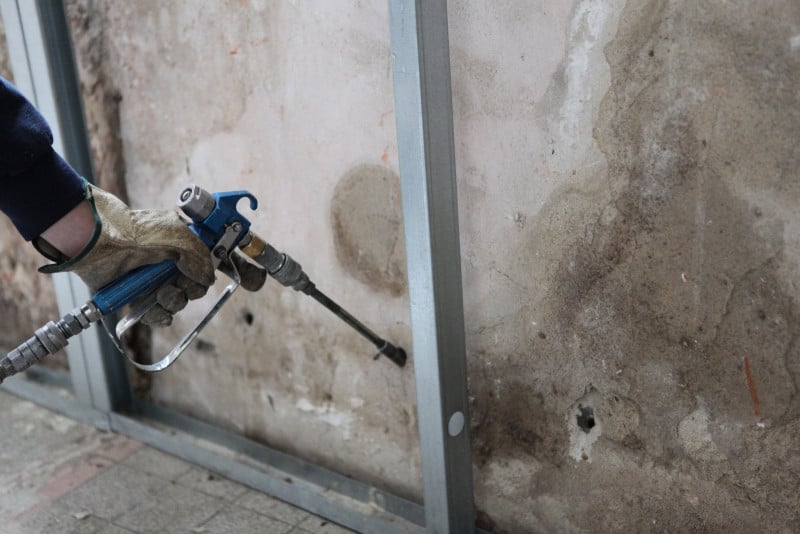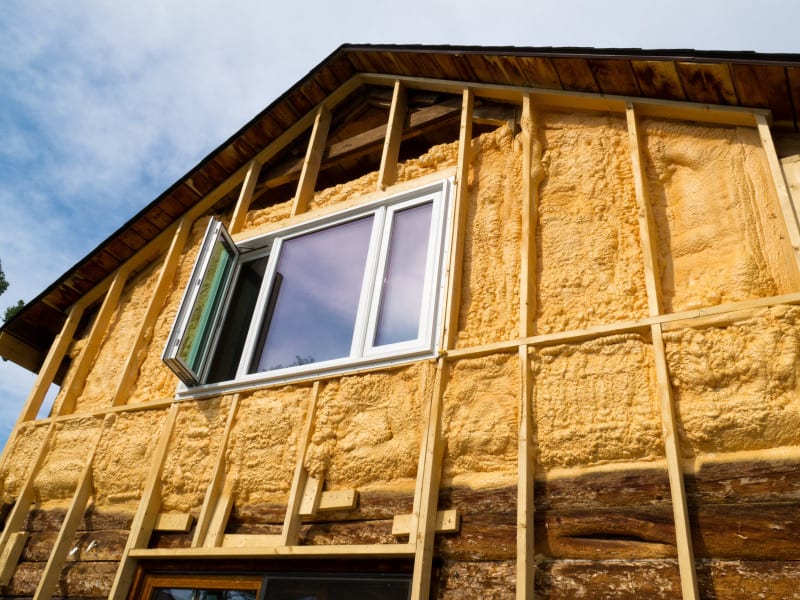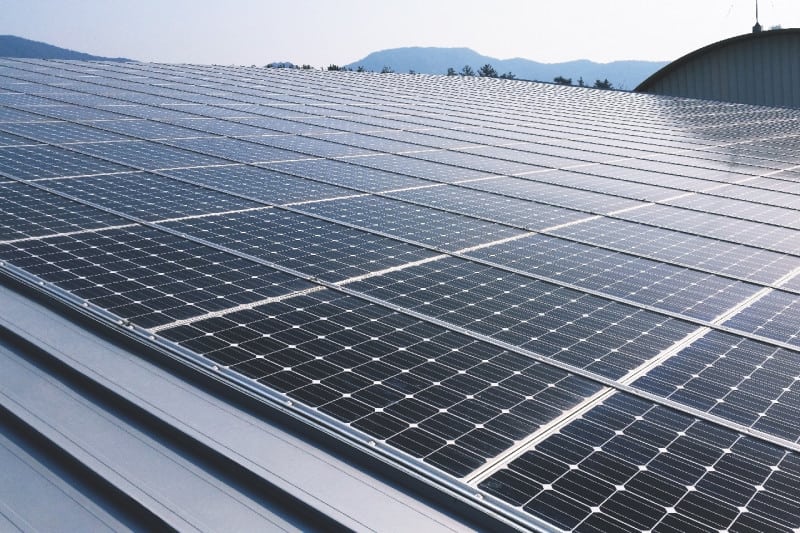Are you tired of feeling drafts and seeing your energy bills skyrocket?
Maybe it’s time to give spray foam insulation a try.
With its ability to seal air leaks, deter moisture and pests, and provide superior insulation compared to other materials like fiberglass, it’s no wonder more homeowners are turning to this solution for their homes.
But how exactly do you use spray foam to insulate your house?
Identify insulation gaps in your house, like walls or attic. Clear the areas and wear safety gear. Shake the foam spray can, then underfill the gap because the foam expands. Let it dry, trim off excess. For best results, ensure even coverage and follow product instructions.
From choosing the right type of foam for your project, to tips on cleaning up uncured foam, we’ll help you get the job done right so that you can enjoy a more comfortable home without breaking the bank.
Let’s get started!
Understanding the Basics of Home Insulation
Before diving into the specifics of spray foam insulation, it’s important to understand the basics of home insulation.
Insulation is a critical component of any home as it helps maintain thermal comfort and energy efficiency by reducing heat transfer between indoor and outdoor spaces.
This can result in significant savings on heating and cooling costs.
Insulation materials come in various forms such as fiberglass, cellulose, and foam.
Spray foam insulation, specifically open-cell and closed-cell spray foam, has been gaining popularity due to its effectiveness in air infiltration control, moisture resistance, soundproofing capabilities, and high R-value.
When considering insulation options for your home, factors such as cost comparison, longevity of the material used, structural integrity impact must be taken into account.
While DIY spray foam installation may seem like a great option for cost savings; professional installation may ensure optimal performance while minimizing health risks associated with exposure to the chemicals present in spray foam.
Understanding basic principles such as thermal resistance will help you make an informed decision when selecting an insulation method that provides maximum benefits for your investment.
What is Spray Foam Insulation and How Does it Work?
Spray foam insulation is a type of home insulation that is applied using a spray gun. It comes in two types: open-cell and closed-cell, each with its unique characteristics.
Open-cell foam has a lower R-value, making it less energy-efficient but more affordable than closed-cell foam.
Closed-cell foam, on the other hand, has better thermal resistance and higher R-value, which makes it more energy-efficient but also pricier.
The main advantage of spray foam insulation is its superior ability to seal air gaps and create an airtight barrier that prevents heat loss or gain.
This not only improves thermal comfort but also enhances indoor air quality by reducing the infiltration of external pollutants such as dust, pollen, and allergens.
Spray foam insulation can also help with soundproofing by reducing noise transmission from outside or between different rooms in the house.
Another benefit is moisture resistance since spray foam doesn’t absorb water like other insulation materials such as fiberglass or cellulose.
However, there are some drawbacks to using spray foam insulation. It requires professional installation due to the complexity of applying it correctly and safely.
DIY spray foam installation can be risky because it involves handling hazardous chemicals that require protective gear and proper ventilation.
Spray foam insulation costs more than traditional options like fiberglass batts or blown-in cellulose.
The return on investment (ROI) depends on various factors such as energy savings over time, local climate conditions, and structural integrity improvement.
In summary, understanding how spray foam works can help you make an informed decision about whether it’s right for your home’s needs.
Keep in mind that while it offers several benefits for improving energy efficiency and indoor air quality, it may not be suitable for every situation or budget constraint without considering professional help ensures safety measures are taken into account during application.
The Benefits and Drawbacks of Spray Foam Insulation
Spray foam insulation is a popular choice for homeowners looking to improve their home’s energy efficiency and thermal comfort. Some of the benefits of spray foam insulation include:
- High R-value: Spray foam has a high R-value, which means it provides excellent thermal resistance and can help reduce energy costs.
- Energy Efficiency: By reducing air infiltration, spray foam insulation can make your home more energy-efficient, lowering your carbon footprint and utility bills.
- Soundproofing: Spray foam insulation also offers soundproofing properties, making it an excellent choice for homeowners who live in noisy neighborhoods or near busy roads.
- Moisture Resistance: Closed-cell spray foam insulation provides a moisture barrier that can prevent mold growth and protect your home from water damage.
However, there are also some drawbacks to using spray foam insulation:
- Cost: Spray foam installation can be expensive compared to other types of insulation materials.
- Professional Installation Required: Proper installation of spray foam requires experience and specialized equipment. DIY installation may result in poor performance or even safety risks.
- Indoor Air Quality Concerns: Improperly installed spray foam can release harmful chemicals into the indoor air. It is important to hire a professional who follows proper safety protocols when installing this type of insulation.
Before deciding on whether or not to use spray foam insulation in your home, consider the benefits and drawbacks carefully.
Consult with professionals who have extensive knowledge about different types of insulating materials.
DIY vs Professional Installation of Spray Foam Insulation
While spray foam insulation can be a great DIY project for homeowners, it’s important to note that professional installation may offer some advantages.
Professional installers have access to high-quality equipment and materials, as well as the expertise needed to ensure proper insulation coverage.
They can often complete the job more quickly than a homeowner could on their own.
However, there are also benefits to doing it yourself.
DIY spray foam insulation allows you to save money on installation costs and gives you full control over the process.
It can also be a fun project for those who enjoy hands-on work and want to learn new skills.
When deciding whether to go with professional or DIY installation, consider your budget, time frame, and skill level.
If you’re comfortable working with tools and have experience with home improvement projects, then DIY may be the way to go.
But if you’re unsure about your ability or don’t have the necessary tools or equipment at hand, then hiring a professional installer might be your best bet.
Either way, proper insulation is crucial for maintaining energy efficiency in your home.
According to EnergyStar.gov’s R-value recommendations by region map of the United States:
- Open-cell spray foam typically has an R-value of 3-4 per inch.
- Closed-cell spray foam typically has an R-value of 6-7 per inch.
By properly insulating your home with either open-cell or closed-cell spray foam insulation materials (or both), you’ll not only increase thermal comfort but also soundproofing capabilities while reducing air infiltration and moisture resistance issues in attics & crawlspaces alike which leads return on investment (ROI) through energy savings over time while improving indoor air quality too!
The Cost and ROI of Spray Foam Insulation
While spray foam insulation may have a higher upfront cost compared to other insulation materials like fiberglass or cellulose, it offers long-term benefits that can provide a return on investment (ROI) over time.
Spray foam insulation has a high R-value, which measures thermal resistance.
This means that it’s more energy-efficient and can save you money on heating and cooling costs in the long run.
The cost of spray foam insulation varies depending on factors such as the size of your home, the type of spray foam used (open-cell or closed-cell), and whether you choose to do DIY installation or hire professionals.
On average, expect to pay between $1.50 and $3 per square foot for open-cell spray foam and between $2 and $4 per square foot for closed-cell spray foam.
When comparing costs with other types of insulation materials, keep in mind that while spray foam may be more expensive upfront, its longevity makes it a worthwhile investment.
Unlike traditional fiberglass or cellulose insulation, which can deteriorate over time due to moisture absorption or settling, spray foam maintains its structural integrity for decades.
In addition to saving money on energy bills and providing ROI through increased home value, there are other benefits to using spray foam insulation.
It also provides soundproofing capabilities and reduces air infiltration by sealing gaps where outside air can enter the home.
Plus, because it resists moisture buildup within walls – an issue common with other types of insulation – it helps protect against mold growth that could negatively impact indoor air quality.
While there is an initial cost associated with installing spray foam insulation in your home, the long-term savings potential in energy efficiency coupled with added benefits like improved indoor air quality make it worth considering as an investment in your home’s comfort and livability.
Conclusion
Spray foam insulation is a powerful tool that homeowners can employ to increase their home’s energy efficiency, reduce unwanted drafts and noise, and protect against moisture infiltration and pest intrusion.
As we’ve discussed, spray foam insulation, either in its open-cell or closed-cell form, provides a superior level of insulation compared to traditional materials, like fiberglass and cellulose.
However, the process of installing spray foam insulation isn’t without its challenges.
It requires a careful understanding of the material, safety protocols, and the installation process, which is why hiring a professional might be the best route for many homeowners.
Although the upfront cost may be higher than other insulation types, the long-term benefits in terms of energy savings, durability, and indoor air quality improvement can provide significant return on your investment.

